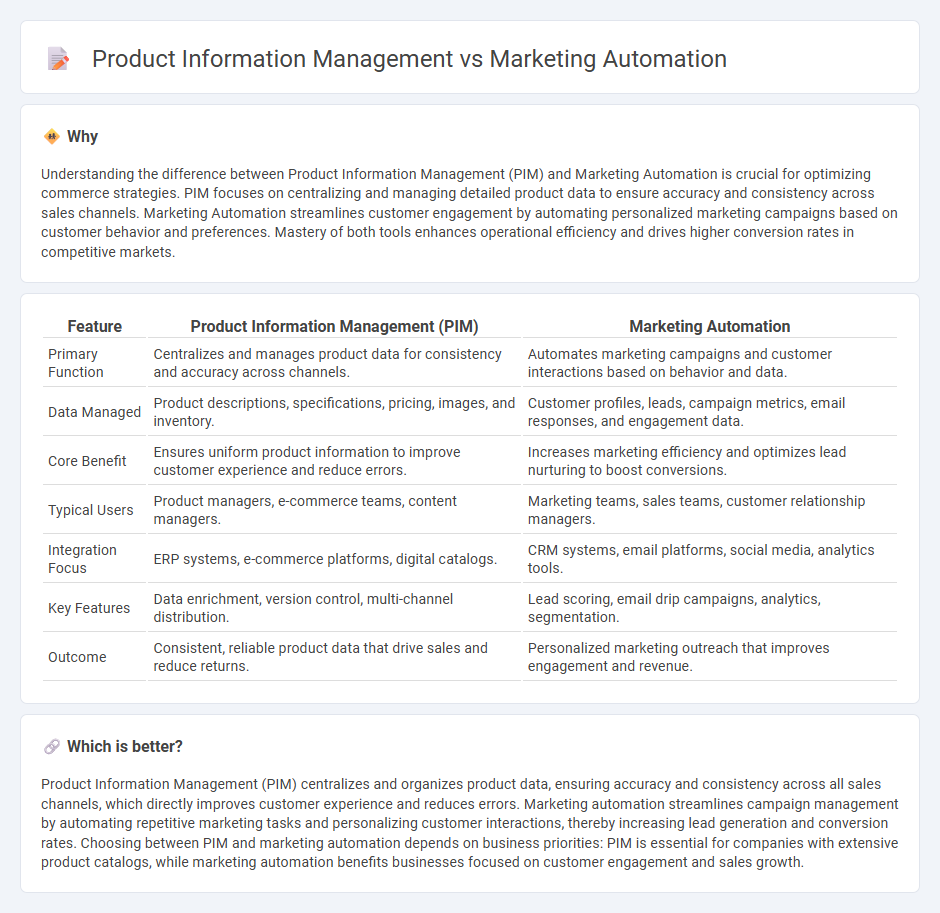
Product Information Management (PIM) centralizes and organizes product data to ensure accuracy and consistency across all sales channels. Marketing Automation streamlines and personalizes customer engagement by automating marketing campaigns and workflows. Explore how integrating PIM with Marketing Automation can elevate your commerce strategy.
Why it is important
Understanding the difference between Product Information Management (PIM) and Marketing Automation is crucial for optimizing commerce strategies. PIM focuses on centralizing and managing detailed product data to ensure accuracy and consistency across sales channels. Marketing Automation streamlines customer engagement by automating personalized marketing campaigns based on customer behavior and preferences. Mastery of both tools enhances operational efficiency and drives higher conversion rates in competitive markets.
Comparison Table
| Feature | Product Information Management (PIM) | Marketing Automation |
|---|---|---|
| Primary Function | Centralizes and manages product data for consistency and accuracy across channels. | Automates marketing campaigns and customer interactions based on behavior and data. |
| Data Managed | Product descriptions, specifications, pricing, images, and inventory. | Customer profiles, leads, campaign metrics, email responses, and engagement data. |
| Core Benefit | Ensures uniform product information to improve customer experience and reduce errors. | Increases marketing efficiency and optimizes lead nurturing to boost conversions. |
| Typical Users | Product managers, e-commerce teams, content managers. | Marketing teams, sales teams, customer relationship managers. |
| Integration Focus | ERP systems, e-commerce platforms, digital catalogs. | CRM systems, email platforms, social media, analytics tools. |
| Key Features | Data enrichment, version control, multi-channel distribution. | Lead scoring, email drip campaigns, analytics, segmentation. |
| Outcome | Consistent, reliable product data that drive sales and reduce returns. | Personalized marketing outreach that improves engagement and revenue. |
Which is better?
Product Information Management (PIM) centralizes and organizes product data, ensuring accuracy and consistency across all sales channels, which directly improves customer experience and reduces errors. Marketing automation streamlines campaign management by automating repetitive marketing tasks and personalizing customer interactions, thereby increasing lead generation and conversion rates. Choosing between PIM and marketing automation depends on business priorities: PIM is essential for companies with extensive product catalogs, while marketing automation benefits businesses focused on customer engagement and sales growth.
Connection
Product Information Management (PIM) centralizes accurate and consistent product data, enabling Marketing Automation systems to deliver personalized and targeted campaigns effectively. Integrating PIM with Marketing Automation enhances customer experience by ensuring timely and relevant product content across multiple channels. This connection streamlines workflows, reduces errors, and accelerates go-to-market strategies for commerce businesses.
Key Terms
Customer segmentation
Marketing automation streamlines customer segmentation by using behavioral data and engagement patterns to deliver personalized campaigns at scale. Product information management (PIM) enhances customer segmentation by ensuring consistent, detailed product data that improves targeting and relevance across sales channels. Explore how integrating marketing automation with PIM elevates customer segmentation strategies for maximum impact.
Workflow automation
Marketing automation streamlines campaign management by automating repetitive tasks like email marketing, lead nurturing, and social media scheduling, enhancing customer engagement and conversion rates. Product information management (PIM) centralizes and organizes product data, ensuring accurate, consistent, and up-to-date information across multiple sales channels, which improves data quality and accelerates product launches. Explore more about how workflow automation bridges marketing automation and PIM to optimize operational efficiency and drive business growth.
Centralized product data
Marketing automation streamlines the execution of marketing campaigns by leveraging customer data and behavior insights, while Product Information Management (PIM) centralizes and organizes detailed product data across multiple channels. Centralized product data in PIM systems ensures consistent, accurate, and enriched product information that enhances marketing automation efforts with reliable content and improved customer experiences. Explore how integrating marketing automation with PIM drives efficiency and boosts sales by maintaining a single source of truth for all product data.
Source and External Links
What is Marketing Automation? | Salesforce US - Marketing automation is technology that automates marketing tasks and campaigns across multiple channels using rules or workflows, helping businesses save time, reduce errors, send personalized messages, and improve marketing effectiveness through data-driven decisions.
Marketing automation - Wikipedia - Marketing automation refers to software platforms used by marketing teams to automate repetitive tasks like lead generation, segmentation, nurturing, scoring, and retention, often integrating with CRM to track customer interactions and optimize marketing ROI.
Learn about marketing automation and how it works - Marketing automation streamlines and personalizes customer interactions by automating email campaigns, social media posts, lead scoring, and ad retargeting, enhancing lead nurturing and conversion while integrating with CRM systems to align marketing and sales efforts.
 dowidth.com
dowidth.com